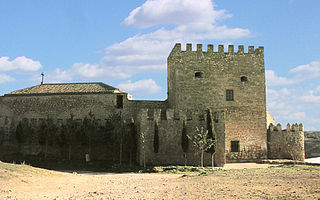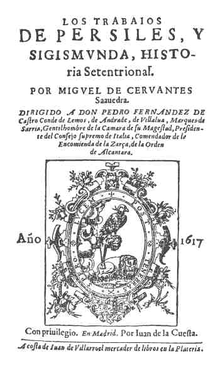
Don Quixote is a Spanish epic novel by Miguel de Cervantes. It was originally published in two parts, in 1605 and 1615. Considered a founding work of Western literature, it is often labelled as the first modern novel and the greatest work ever written. Don Quixote is also one of the most-translated books in the world and one of the best-selling novels of all time.

Miguel de Cervantes Saavedra was an Early Modern Spanish writer widely regarded as the greatest writer in the Spanish language and one of the world's pre-eminent novelists. He is best known for his novel Don Quixote, a work often cited as both the first modern novel and "the first great novel of world literature". A 2002 poll of 100 well-known authors voted it the "best book of all time", as voted by the judges from among the "best and most central works in world literature".
This article contains information about the literary events and publications of 1617.

Tirant lo Blanch, in English Tirant the White, is a chivalric romance written by the Valencian knight Joanot Martorell, finished posthumously by his friend Martí Joan de Galba and published in the city of Valencia in 1490 as an incunabulum edition. The title means "Tirant the White" and is the name of the romance's main character who saves the Byzantine Empire.

Sancho Panza is a fictional character in the novel Don Quixote written by Spanish author Miguel de Cervantes Saavedra in 1605. Sancho acts as squire to Don Quixote and provides comments throughout the novel, known as sanchismos, that are a combination of broad humour, ironic Spanish proverbs, and earthy wit. "Panza" in Spanish means "belly".

Rocinante is Don Quixote's horse in the two-part 1605/1615 novel Don Quixote by Miguel de Cervantes. In many ways, Rocinante is not only Don Quixote's horse, but also his double; like Don Quixote, he is awkward, past his prime, and engaged in a task beyond his capacities.

La Galatea was Miguel de Cervantes’ first book, published in 1585. Under the guise of pastoral characters, it is an examination of love and contains many allusions to contemporary literary figures. It enjoyed modest success, but was not soon reprinted; its promised sequel was never published.

Alonso Fernández de Avellaneda is the pseudonym of a man who wrote a sequel to Cervantes' Don Quixote, before Cervantes finished and published his own second volume.

Fierabras or Ferumbras is a fictional Saracen knight appearing in several chansons de geste and other material relating to the Matter of France. He is the son of Balan, king of Spain, and is frequently shown in conflict with Roland and the Twelve Peers, especially Oliver, whose prowess he almost rivals. Fierabras eventually converts to Christianity and fights for Charlemagne.

Cide Hamete Benengeli is a fictional Arab Muslim historian created by Miguel de Cervantes in his novel Don Quixote, who Cervantes says is the true author of most of the work. This is a skilful metafictional literary pirouette that seems to give more credibility to the text, making the reader believe that Don Quixote was a real person and the story is decades old. However, it is obvious to the reader that such a thing is impossible, and that the pretense of Cide Hamete's work is meant as a joke.

Argamasilla de Alba is a municipality in the Province of Ciudad Real, Castile-La Mancha, Spain. It has a population of 6,791.
Frederick A. de Armas is a literary scholar, critic and novelist who is Robert O. Anderson Distinguished Service Professor in Humanities at the University of Chicago.

Hispanism is the study of the literature and culture of the Spanish-speaking world, principally that of Spain and Hispanic America. It may also entail studying Spanish language and cultural history in the United States and in other presently or formerly Spanish-speaking countries in Africa, Asia, and the Pacific, such as Equatorial Guinea and the former Spanish East Indies.

John Bowle (1725–1788) was an English clergyman and scholar, known today primarily for his ground-breaking, annotated edition of the early 1600s Miguel de Cervantes novel Don Quixote. He is considered to have been the first Hispanist.

Cayetano Hilario Abellán was a Spanish self-taught sculptor who produced sculptures based on different themes. His work is known because of his group of characters from the Miguel de Cervantes' well known novel Don Quixote, among others.

The Musical Sancho Panza is a two-act 2005 Spanish musical which premiered in Madrid to coincide with the 400th anniversary of the publication of Don Quixote. by Miguel de Cervantes. The play is a humorously presented look at the social landscape of the 16th and 17th centuries, including the customs, beliefs, professions, and trades of the era, while updating those points of the play by displaying it in the looks and forms of the 21st century.
Jean Canavaggio was a French biographer and emeritus professor of Spanish literature at the Paris West University Nanterre La Défense.
Andres Rossi was a Spanish artist. He worked as a painter, draughtsman, print maker, sculptor and writer in Madrid and Seville.
Gachupín is a Spanish-language term derived from a noble surname of northern Spain, the Cachopín of Laredo. It was popularized during the Spanish Golden Age as a stereotype and literary stock character representing the hidalgo class which was characterized as arrogant and overbearing. It may also be spelled cachopín, guachapín, chaupín or cachupino. The term remained popular in Mexico, where it would come to be used in the Cry of Dolores.














